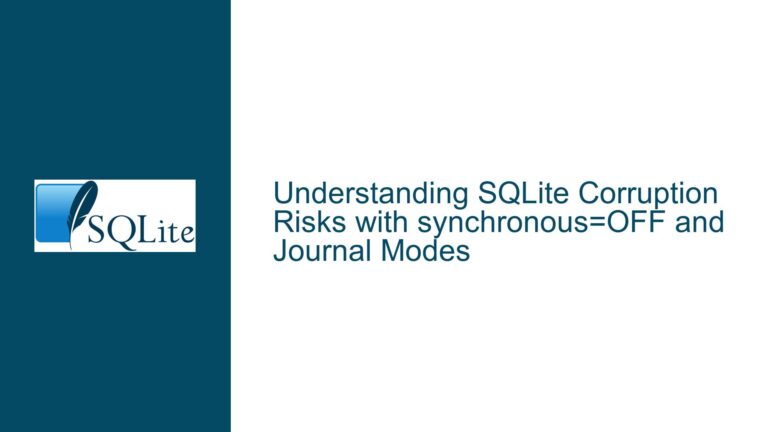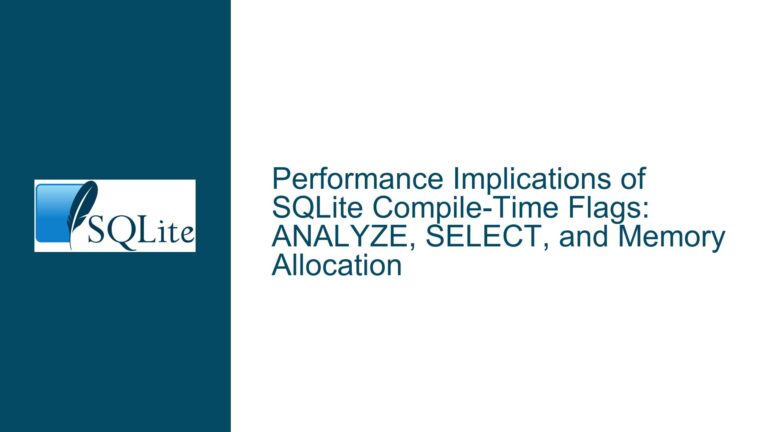Optimizing DISTINCT Queries in SQLite Virtual Tables
Virtual Table DISTINCT Query Performance Limitations
The core issue revolves around the inability of SQLite virtual tables to optimize queries involving the DISTINCT keyword. When a DISTINCT query is executed against a virtual table, the virtual table must generate all possible rows, including duplicates, and the SQLite core subsequently filters out the duplicates. This approach is highly inefficient, especially when the virtual table has a large number of rows or when the virtual table implementation could inherently avoid generating duplicates by leveraging internal knowledge or indexes.
For example, consider a virtual table named id_mapping that encodes structured IDs as 64-bit integers. This table has columns for the ID, type, type name, type-specific part, generic ID, and generic ID name. The id_mapping table theoretically contains 2^63 rows, making a full table scan impractical. However, the type_name column has a limited set of values (e.g., "TypeA", "TypeB"), which are essentially hard-coded enums within the virtual table implementation. A query like SELECT DISTINCT type_name FROM id_mapping should ideally return the distinct type names in nanoseconds by iterating over the enum values. Instead, the current implementation requires the virtual table to generate all 2^63 rows, which would take an impractical amount of time.
The root of the problem lies in the SQLite virtual table interface, specifically the xBestIndex method. This method is responsible for determining the most efficient way to execute a query against the virtual table. However, the xBestIndex method does not receive any information about whether the query involves a DISTINCT clause. As a result, the virtual table cannot optimize its behavior to avoid generating duplicate rows when a DISTINCT query is executed.
Lack of DISTINCT Awareness in xBestIndex Method
The primary cause of the inefficiency in handling DISTINCT queries in virtual tables is the lack of awareness of the DISTINCT clause within the xBestIndex method. The xBestIndex method is a critical part of the SQLite virtual table interface, allowing the virtual table to propose an optimal query plan based on the constraints and columns used in the query. However, the current interface does not provide any mechanism for the virtual table to determine whether the query involves a DISTINCT clause.
The xBestIndex method receives an sqlite3_index_info structure, which contains information about the query, such as the columns used (colUsed mask), constraints, and order-by clauses. However, this structure does not include any flag or field to indicate whether the query is a DISTINCT query. This omission prevents the virtual table from optimizing its behavior for DISTINCT queries, even when it has the internal knowledge or indexes to do so efficiently.
For instance, in the id_mapping virtual table example, the virtual table could theoretically use its internal enum values to directly return distinct type_name values without generating all possible rows. However, since the xBestIndex method does not know that the query is a DISTINCT query, it cannot propose this optimization. Instead, the virtual table must generate all rows, and the SQLite core must subsequently filter out the duplicates, leading to significant inefficiency.
Another contributing factor is the complexity of the SQLite query engine. Even if the xBestIndex method were extended to include a DISTINCT flag, there would be challenges in ensuring that this flag is correctly passed to the virtual table in all relevant scenarios. For example, in queries involving joins, subqueries, or complex expressions, it may not always be straightforward to determine whether the DISTINCT clause can be safely passed to the virtual table. However, for simple queries where all selected columns are from the same virtual table, it should be relatively straightforward to pass the DISTINCT flag to the virtual table.
Enhancing xBestIndex with DISTINCT Awareness and Query Optimization
To address the inefficiency of DISTINCT queries in virtual tables, the SQLite virtual table interface should be extended to provide DISTINCT awareness to the xBestIndex method. This enhancement would involve adding a flag to the sqlite3_index_info structure to indicate whether the query involves a DISTINCT clause. This flag would allow the virtual table to optimize its behavior for DISTINCT queries, avoiding the generation of duplicate rows when possible.
The proposed enhancement would involve the following steps:
Extend the
sqlite3_index_infoStructure: Add a new flag, such asSQLITE_INDEX_DISTINCT, to thesqlite3_index_infostructure. This flag would be set by the SQLite core when the query involves aDISTINCTclause.Modify the
xBestIndexMethod: Update thexBestIndexmethod to check for theSQLITE_INDEX_DISTINCTflag. If the flag is set, the virtual table can propose an optimized query plan that avoids generating duplicate rows. For example, in theid_mappingvirtual table, thexBestIndexmethod could propose a plan that directly iterates over the enum values for thetype_namecolumn.Update the SQLite Query Engine: Modify the SQLite query engine to correctly set the
SQLITE_INDEX_DISTINCTflag in thesqlite3_index_infostructure for queries involving theDISTINCTclause. This modification would need to handle various query complexities, such as joins, subqueries, and complex expressions, to ensure that the flag is only set when it is safe to do so.Document the New Feature: Update the SQLite documentation to describe the new
SQLITE_INDEX_DISTINCTflag and provide guidance on how virtual table implementations can use this flag to optimizeDISTINCTqueries.
In addition to the DISTINCT awareness, other improvements to the virtual table interface could further enhance query performance and flexibility. These improvements include:
- Support for LIMIT/OFFSET Clauses: Allow virtual tables to consume
LIMITandOFFSETclauses, enabling more efficient handling of paginated queries. - Indexing on Expressions: Enable virtual tables to support indexing on expressions, including non-deterministic functions like
RANDOM(), to optimize queries involving complex expressions. - True/False Constraint Types: Introduce true and false constraint types for virtual tables, allowing more precise optimization of queries involving boolean expressions.
- Batch Updates: Support batch updates for virtual tables, enabling optimizations like the truncate optimization.
- Minimizing
colUsedValues: Allow virtual tables to minimize thecolUsedvalues in thesqlite3_index_infostructure, reducing unnecessary data generation when columns are only used in constraints or order-by clauses. - Leveraging UNIQUE Constraints: Enable virtual tables to use declared
UNIQUEconstraints to optimize queries, reducing the need for duplicate filtering. - Query Interruption Detection: Provide a less kludgy way for virtual tables to detect query interruptions, especially for long-running operations.
By implementing these enhancements, the SQLite virtual table interface would become more powerful and flexible, enabling virtual table implementations to optimize a wider range of queries and improve overall performance. The addition of DISTINCT awareness to the xBestIndex method would be a significant step forward, allowing virtual tables to efficiently handle DISTINCT queries without generating unnecessary duplicate rows.
In conclusion, the current limitations of the SQLite virtual table interface in handling DISTINCT queries stem from the lack of DISTINCT awareness in the xBestIndex method. By extending the sqlite3_index_info structure to include a DISTINCT flag and updating the xBestIndex method to leverage this flag, virtual tables can optimize DISTINCT queries and avoid the inefficiency of generating and filtering duplicate rows. This enhancement, along with other proposed improvements to the virtual table interface, would significantly enhance the performance and flexibility of SQLite virtual tables.






